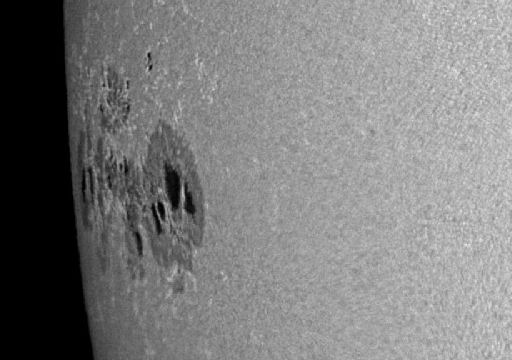Turn your cell phone into a field-tested satellite tracker. Works for Android and iPhone. | | | HISTORIC SPACE DOCKING: China's new space station, the Tiangong 1, is making a series of pre-dawn flybys over North America this week. People who wake up to see the "Heavenly Palace" might spot a second spacecraft nearby: Shenzhou 8, an unmanned vessel launched Oct 31st is chasing the space station for China's first space docking. The rendezvous could occur as early as Nov. 2nd. Check the Satellite Tracker or your smartphone for local flyby times. double flyby photos: from Bryan Murahashi of San Jose, California BIG SUNSPOT: A large sunspot group is rotating over the sun's northeastern limb, possibly signaling an uptick in solar activity. Amateur astronomer Pavol Rapavy of Slovakia took this picture just a few hours ago: 
Measuring some 40,000 km wide and at least twice that in length, the behemoth active region is an easy target for backyard solar telescopes. Astronomers are encouraged to monitor the region: NOAA forecasters estimate a 60% chance of M-class solar flares during the next 24 hours. Eruptions today would not be Earth directed, but future eruptions could be as the sunspot turns toward our planet in the days ahead. Solar flare alerts: text, voice. NORTHERN LIGHTS: November began with a geomagnetic storm. A shock wave in the solar wind swept past Earth during the early hours of Nov 1st, sparking strong magnetic disturbances around the Arctic Circle. Paul Beebe sends this report from Upsala, Canada: "I awoke around 6:30 am and saw auroras out my bedroom window. They were dancing like green flames in the northern sky, with the occasional spike of pink or red barely visible." He quickly dressed and headed to the shores of nearby Lang Lake for this shot: 
More auroras are possible on Nov. 4th. A coronal mass ejection (CME) left the sun on Oct. 31st when a solar filament erupted; the cloud could deliver a glancing blow to Earth's magnetic field this Thursday. Aurora alerts: text, voice. October 2011 Aurora Gallery
[previous Octobers: 2010, 2009, 2008, 2007, 2006, 2004, 2003, 2002] Potentially Hazardous Asteroids ( PHAs) are space rocks larger than approximately 100m that can come closer to Earth than 0.05 AU. None of the known PHAs is on a collision course with our planet, although astronomers are finding new ones all the time. On November 2, 2011 there were 1256 potentially hazardous asteroids. Notes: LD means "Lunar Distance." 1 LD = 384,401 km, the distance between Earth and the Moon. 1 LD also equals 0.00256 AU. MAG is the visual magnitude of the asteroid on the date of closest approach. | | The official U.S. government space weather bureau | | | The first place to look for information about sundogs, pillars, rainbows and related phenomena. | | | Researchers call it a "Hubble for the sun." SDO is the most advanced solar observatory ever. | | | 3D views of the sun from NASA's Solar and Terrestrial Relations Observatory | | | Realtime and archival images of the Sun from SOHO. | | | from the NOAA Space Environment Center | | | the underlying science of space weather | | | for out-of-this-world printing and graphics | | 
